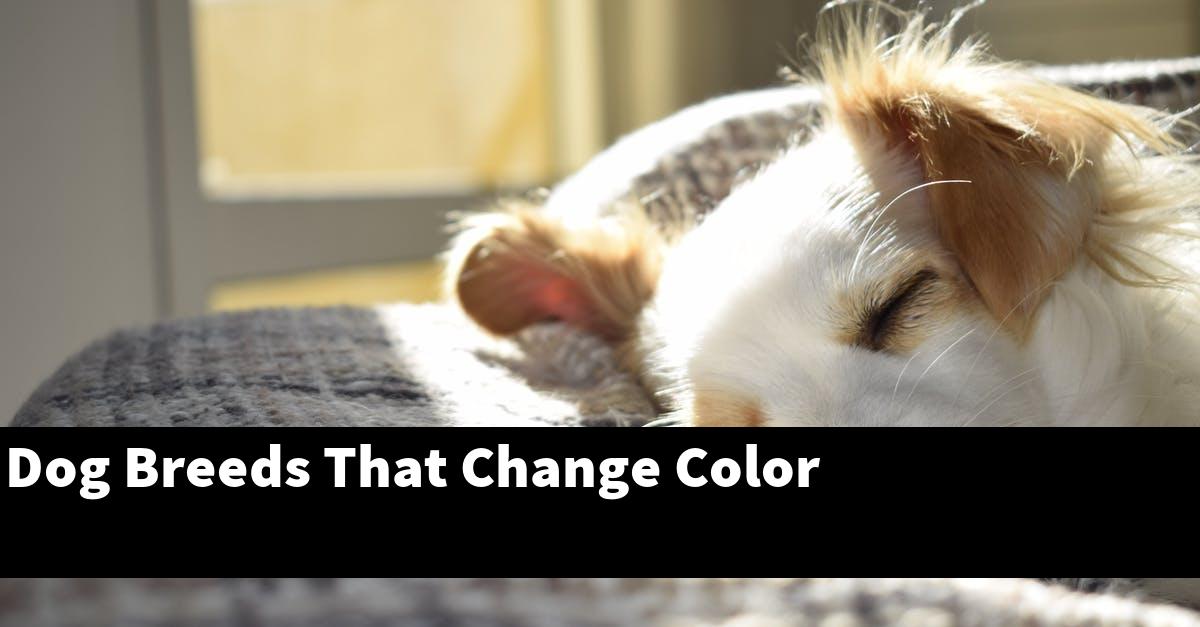Many dog breeds can change color as they age. Some of the most popular breeds that change color are Labradors, Golden Retrievers, and Border Collies. The change in color is usually due to a change in the pigment cells in the dog’s skin.
The article will be discussing dog breeds that change color, specifically discussing why and how the color change occurs.
Table of Contents
What are some dog breeds that change color?
Some dogs change color as they mature. For example, a black Labrador Retriever may turn brown or red. This is due to a change in their coat’s pigment. Other dogs may be born with a coat that changes color.
For example, an Australian Cattle Dog may be born black, but as it matures, its coat may turn blue or red.
Why do some dog breeds change color?
As puppies, many dogs will have a coat that is different in color from their adult coat. This is due to a change in the type of hair they have as they mature. The new hair is usually darker and thicker than the puppy hair.
There are a few exceptions to this rule. Some dogs, like the Australian Cattle Dog, will have a coat that is mostly white as a puppy. This breed’s coat will darken as the dog matures, but the white markings will remain.
There are also a few breeds that are born with a coat that is different from their adult coat. These dogs will usually have a coat that is lighter in color as a puppy. As they mature, their coat will darken to the adult color.
The reason for these changes in coat color is not fully understood. It is thought that the change is due to a combination of genetics and the environment.
How do dog breeds that change color compare to other dog breeds?
Dog breeds that change color are not necessarily better or worse than other dog breeds; it simply depends on the individual dog. Some dogs that change color may be more prone to certain health conditions, but this varies from dog to dog. It is important to do your research before getting any dog, regardless of breed, to make sure you are getting a healthy animal.
What are the benefits and drawbacks of owning a dog breed that changes color?
While there are many different dog breeds that change color, there are a few that stand out as being particularly popular. The benefits of owning a dog breed that changes color include the fact that they are often very beautiful dogs. They can also be quite unique, which can make them a conversation starter.
In addition, these dogs tend to be very loyal and loving, which can make them great companions. However, there are also some drawbacks to owning a dog breed that changes color. For one, they can be more expensive than other dog breeds. In addition, they may require special care and attention in order to keep their coat looking its best.
Why is my dogs fur changing Colour?
The coat of a dog can change color for a number of reasons. The most common reason is due to the change in seasons. As the weather gets colder, the coat of a dog will often darken in color. This is because the coat is thicker and contains more melanin, which is a pigment that gives color to the hair.
Another reason why a dog’s fur may change color is due to illness or poor nutrition. If a dog is not getting enough of the right nutrients, the coat may become dull and the hair may fall out. This can lead to patchy fur and a change in color.
Finally, some dogs simply have coats that change color as they age. This is most common in dogs with black fur, which may turn gray or silver as the dog gets older.
Can a puppies fur change color?
Many people are surprised to learn that puppies’ fur can change color. This is because the color of a puppy’s fur is determined by the presence of two pigments: eumelanin and pheomelanin. Eumelanin is a black pigment, while pheomelanin is a red pigment.
Puppies are born with only eumelanin, which gives them a black coat. However, as they age, they begin to develop pheomelanin, which gives them a red coat. The amount of pheomelanin in a puppy’s coat will determine the final color of the coat.
For example, if a puppy has a lot of pheomelanin, the coat will be red. If the puppy has only a little pheomelanin, the coat will be black.
So, to answer the question, “Can a puppies fur change color?” the answer is yes, it can.
Conclusion
Many people don’t realize that some dog breeds can change color as they age. This is most common in small breeds, but it can happen in any breed, including mixed breeds. The change is usually gradual, but it can be sudden in some cases. The new color may be lighter or darker than the original color, and it may be a different shade altogether.
There are a few theories about why dogs change color. One is that the change is caused by a loss of pigment in the hair. This can happen as a result of aging, sun exposure, or other factors. Another theory is that the change is due to a change in the hair shaft itself. This is most common in breeds with thick, double-coated hair, such as Huskies.
Whatever the cause, color changes in dogs are usually nothing to worry about. If you notice your dog’s coat starting to change color, talk to your veterinarian to rule out any underlying health problems.
A dog’s coat changing color is a gradual process that can be exciting to witness. It’s important to note that if your dog’s coat changes color suddenly, it could be indicative of an underlying health problem and you should consult your veterinarian. Other than that, a color change in a dog’s coat is usually due to a loss of pigment or a change in the shaft of the hair and is nothing to worry about.


